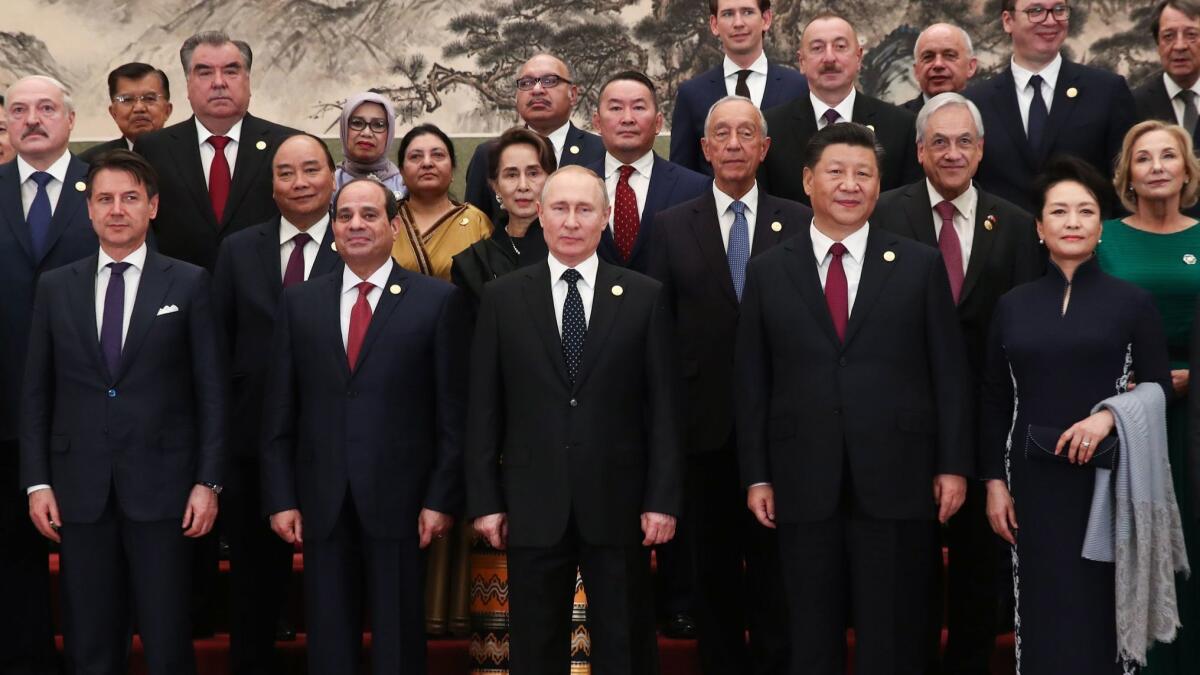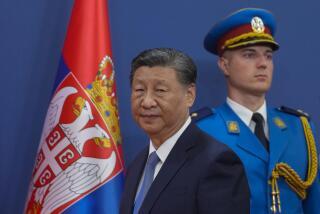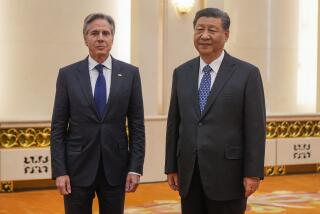In China, rebranding a foreign loan initiative to calm fears over geopolitical reach

- Share via
Reporting from Beijing — China’s flagship foreign policy initiative, designed to provide loans for infrastructure projects in developing nations, will meet higher standards for environmental protection and safeguards against corruption, Chinese President Xi Jinping said Friday in a keynote address at an international Belt and Road Initiative forum in Beijing.
“In pursuing the Belt and Road, everything should be done in a transparent way and we should have zero tolerance for corruption,” said Xi, addressing some 40 global leaders and 5,000 attendees at the conference, the second since the investment program was launched in 2013.
With more than $440 billion in loans already targeted to development projects across Asia, Africa, Europe and Latin America, the program has led to agreements with 125 countries. But it has also resulted in questions and criticism about the level of debt incurred by participating countries and whether China is using it as a geopolitical tool to trap developing nations in order to expand its worldwide influence.
The global lending project came under scrutiny in December 2017, when Sri Lanka, unable to meet debt payments on a port that China constructed, handed the port over to China on a 99-year lease. The incident caused widespread accusations that this was China’s secret strategy: “debt trap diplomacy,” a plan to load developing countries with unmanageable debt, then take over strategic assets when they default.
In a markedly moderate speech, Xi, who in 2013 called Belt and Road “the project of the century” amid imagery of ancient travels across the ancient Silk Road, stressed Friday that China’s overseas projects would meet higher standards on debt, environmental protection and corruption.
He called for the adoption of “international acceptable” standards in the bidding process for the projects and framed it as a multilateral initiative, inviting participation from financial institutions and encouraging other nations to co-finance projects.
There are no official statistics on how much has been repaid thus far, or how much of the debt is at risk of default, according to China’s central bank governor, Yi Gang. The lowest estimate of how much China will spend on Belt and Road in total, based on infrastructure promises, averages around $1 trillion.
Belt and Road originally referred to a trail of Chinese infrastructure projects along land and sea routes between China and Europe. But other countries outside the route have since joined and critics, including the Trump administration, have questioned just what China is using the “Belt” for.
Vice President Mike Pence, speaking at an Asia Pacific Economic Cooperation summit in November, said, “We don’t drown our partners in a sea of debt, we don’t coerce, compromise your independence. We do not offer a constricting belt or a one-way road.”
“When China comes calling, it’s not always to the good of your citizens,” Secretary of State Michael R. Pompeo said at a news conference in Mexico in October. He said Chinese state-owned enterprises were “clearly not transparent, clearly not market-driven,” and designed not to benefit local people, “but rather to benefit the Chinese government.”
Some scholars counter that there is no evidence that China’s plan is to entrap developing countries. Deborah Brautigam, director of the Africa-China Research Initiative at Johns Hopkins University, said the Sri Lanka port is the only one out of more than 3,000 Belt and Road projects that has ended in a 99-year lease.
“We’ve not seen a pattern of deliberate entrapment in order to get some strategic advantage,” Brautigam said.
In a 2018 study of African countries’ debt, Brautigam found that China was the major creditor to three countries at high risk of debt distress: Zambia, Djibouti and Congo. In the other 14 low-income countries at risk of debt distress, China’s share of the debt was less than that of other major lenders such as the World Bank and the Paris Club, an informal group of mostly wealthy countries including France, Japan and the United States.
“If you look historically, the debt trap issue was not caused by Chinese loans alone. Most debt was historically accumulated by the loans from the World Bank, Asian Development Bank, other institutions,” said Baogang He, an international relations professor at Australia’s Deakin University. “So China is an additional factor that’s deepening the debt, but China is not alone.”
Nadège Rolland, a political expert at the National Bureau of Asian Research, said China has a history of using economic power for political goals, but that doesn’t mean every Belt and Road deal is meant as a trap.
“The use of the economic instrument both as incentive and as a possible coercive tool is definitely in the line of what Beijing is thinking,” Rolland said. “But ‘debt trap diplomacy’ gives it a level of intention that I’m not sure Beijing had. They probably just seized this opportunity.”
China has also shown willingness to cancel or renegotiate debt. According to consultants Development Reimagined and the Oxford China Africa Consultancy, China had canceled or restructured 98 instances of debt from 2000 to 2018, totaling $9.8 billion. However, most of those cancellations were for values of less than $100 million, and there have been fewer cancellations since 2013.
Developing countries should negotiate more to secure favorable deals with China, suggested Hannah Ryder, founder of Development Reimagined and former head of policy and partnerships with the U.N. Development Program in China.
“With China, if you don’t ask, you don’t get,” Ryder said. “It’s up to the countries themselves to say, ‘This is what we want from China. We want a project that is cost-effective.’”
Several Belt and Road countries seem to be doing just that. Malaysian Prime Minister Mahathir Mohamad recently halted and renegotiated a major Belt and Road railway project, cutting the price by one-third. Myanmar cut back the cost of a Chinese port project from $7.3 billion to $1.3 billion last year.
Other countries including Thailand, Nepal, Bangladesh, the Maldives and Pakistan, one of China’s closest allies, have backed away from Chinese projects, cancelling or asking to renegotiate deals.
“Countries are now more cautious. They are more apprehensive of the terms that might complicate each project. So now countries are eager to vet the terms of lending from China before they sign on to something,” said Indian scholar Brahma Chellaney. “Negotiations are going to get touchier for China. It is good, because it cuts down on corrupt practices.”
Corruption and cronyism are major risks since most projects are financed by state banks and implemented by state-owned companies, some with a history of bribery and fraud.
One of the most active state-owned enterprises, the China Communications Construction Co., was debarred by the World Bank for eight years on charges of fraudulent bidding in a Philippines highway project. Last year, Bangladesh blacklisted one of its subsidiaries, China Harbor Engineering Company, for offering bribes to a government official.
In Malaysia, Chinese officials reportedly offered to bail the former government out from a scandalous multibillion-dollar graft case in exchange for Belt and Road deals. In Sri Lanka, money from Belt and Road construction funds went into campaign funds for a former president’s election.
The risk is compounded by the sheer reach of the program and the slowdown of China’s domestic economy.
“It might become a nightmare for China because it’s strategic overreach,” He said.
Chinese officials, however, quarter little patience for criticism of Belt and Road, which is enshrined in the Communist Party Constitution and regularly feted by state media as a sign of China’s benevolent rise.
Last summer, Tsinghua University law professor Xu Zhangrun wrote an essay criticizing Xi and questioning the wisdom of lavishing money on the program when China has economic problems at home. He has since been suspended from teaching.
And in August, 84-year-old retired economics professor Sun Wenguang was criticizing the program in a live phone broadcast interview when police suddenly entered his home and forced him off-air. “People are poor. Let’s not throw our money in Africa,” he said, before the line went dead.
The United States did not send any high-level official to the forum, but its trade talks with China are scheduled to resume next week. President Trump remarked Thursday that Xi would come to the White House soon, without specifying when or why.
Xi did not mention the ongoing U.S.-China trade war in his address Friday but did touch on several of its key issues. He said China would strengthen intellectual property protection, allow foreign businesses to operate in more sectors, lower tariffs, increase imports and avoid currency depreciation.
“We need to promote trade and investment liberalization, to say no to protectionism, to push economic globalization to develop in a more open, inclusive, balanced, win-win direction, ” Xi said.
China’s Belt and Road Forum lays groundwork for a new global order »
How an island nation’s new leaders are trying to unravel a web of secret deals with China »
China has spent billions in Africa, but some critics at home question why »
Globalization 2.0: How China’s two-day summit aims to shape a new world order »
China’s dream of a new Silk Road runs into hurdles at its first stop: Pakistan »
More to Read
Sign up for Essential California
The most important California stories and recommendations in your inbox every morning.
You may occasionally receive promotional content from the Los Angeles Times.











